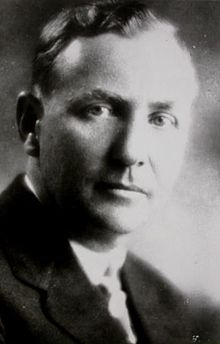John Christoph Blucher Ehringhaus(February 5, 1882 – July 31, 1949) was an American politician who served as the58th governor of North Carolina,serving from 1933 to 1937.
John C. B. Ehringhaus | |
|---|---|
 | |
| 58thGovernor of North Carolina | |
| In office January 5, 1933 – January 7, 1937 | |
| Lieutenant | Alexander H. Graham |
| Preceded by | Oliver Max Gardner |
| Succeeded by | Clyde R. Hoey |
| Member of the North Carolina House of Representatives fromPasquotank County[1][2] | |
| In office 1905–1909 | |
| Preceded by | W.M. Hinton[3] |
| Succeeded by | Seth M. Morgan[4] |
| Personal details | |
| Born | John Christoph Blucher Ehringhaus February 5, 1882 Elizabeth City, North Carolina,U.S. |
| Died | July 31, 1949(aged 67) Raleigh, North Carolina,U.S. |
| Political party | Democratic |
| Spouse | Matilda Haughton |
| Children | 3 |
| Alma mater | University of North Carolina, Chapel Hill(AB,LLB) |
| Profession | Lawyer, politician, farmer |
Biography
editHe was born on February 5, 1882, inElizabeth City, North Carolina.He was a descendent of German immigrant Johann Christoph Ehringhaus, who arrived in North Carolina in the early nineteenth-century and opened a bank in Elizabeth City.[5]The Ehringhaus family remained involved in banking and law in Elizabeth City for generations.[5]
Ehringhaus attended theUniversity of North Carolina at Chapel Hill,he was a member of the Philanthropic society of theDialectic and Philanthropic Societiesfrom 1898 to 1902.[6]
Ehringhaus was a member of the Benevolent and Protective Order of Elks (BPOE), Elizabeth City Lodge #856. He served as District Deputy Grand Exalted Ruler for the North Carolina East District of the BPOE, 1909-1910.
GovernorO. Max Gardnercoaxed Ehringhaus, a former state legislator and attorney, out of political retirement as his hand-picked successor. He narrowly defeatedLieutenant GovernorRichard T. Fountainin a Democratic primaryrunoff.Fountain claimed Ehringhaus was the tool of business interests.[7]
Serving the state during theGreat Depression,Ehringhaus encouraged theNorth Carolina General Assemblyto create a state agency that would help rural areas of the state receive electricity services in order to revive the lagging economy.[8]He also cut state spending, successfully pushed for a three-cent sales tax, extended the school year and kept the schools open and solvent.[9]
He appointed former North Carolinian first ladyCora Lily Woodard Aycockas the President of theNorth Carolina Railroad.[10]
He died on July 31, 1949.
Legacy
editAsked how to say his name, he toldTheLiterary Digest"My name is pronounced as if spelledear'en-house."[11]
A dormitory at theUniversity of North Carolina at Chapel Hill,Ehringhaus' alma mater (class of 1902) is named in his honor,[12]and theDialectic and Philanthropic Societies,of which Ehringhaus was a member, maintains a portrait in his honor.
The second longest bridge in the state of North Carolina, a 3.5-mile stretch over theAlbemarle Sound,is named in honor of this former governor.[13]
Ehringhaus' grave is located in the historicEpiscopal Cemeteryin his hometown ofElizabeth CityinNortheastern North Carolina,and the city's mainthoroughfare,Ehringhaus Street, is named in his honor.
References
edit- ^"North Carolina State House of Representatives - 1905".
- ^"North Carolina State House of Representatives - 1907-1908".www.carolana.com.
- ^"North Carolina State House of Representatives - 1903".
- ^"North Carolina State House of Representatives - 1909".
- ^abChris Klasing (2003)."The Ehringhauses. A German-American Family in North Carolina".usgwarchives.net.RetrievedMarch 3,2024.
- ^"North Carolina manual [serial]".1916.
- ^Christensen, Rob.The Paradox of Tar Heel Politics.2008: UNC Press. p. 77.
- ^North Carolina Historic SitesArchivedDecember 6, 2006, at theWayback Machine
- ^Christensen. p. 89.
- ^"Aycock, Cora Lily Woodard".NCpedia.RetrievedMarch 20,2023.
- ^Charles Earle Funk,What's the Name, Please?,Funk & Wagnalls, 1936.
- ^"Ehringhaus - UNC Housing".May 5, 2020.
- ^"North Carolina Museum of History"(PDF).Archived fromthe original(PDF)on July 27, 2011.